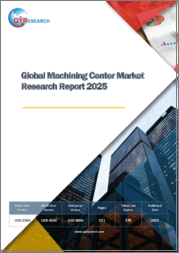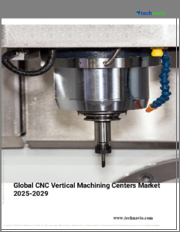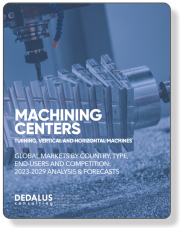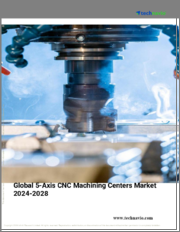
|
시장보고서
상품코드
1593920
머시닝 센터 시장 : 유형, 제품 유형, 메커니즘 유형, 최종 사용자 산업별 - 세계 예측(2025-2030년)Machining Centers Market by Type (Horizontal Machining Center, Universal Machining Center, Vertical Machining Center), Product (3-Axis, 4-Axis, 5-Axis), Mechanism Type, End-user Industry - Global Forecast 2025-2030 |
||||||
머시닝 센터 시장은 2023년에 407억 5,000만 달러로 평가되었습니다. 2024년에는 440억 3,000만 달러에 이를 것으로 예측되며, CAGR 8.54%로 성장하여 2030년에는 723억 3,000만 달러에 달할 것으로 예측됩니다.
머시닝 센터의 범위에는 금속 절단 및 가공에 사용되는 광범위한 공작기계가 포함됩니다. 자동화되고 컴퓨터로 제어되는 장비로 정의되는 머시닝 센터는 특히 자동차, 항공우주, 전자제품과 같은 정밀 부품 제조에 중점을 둔 산업에서 필수적입니다. 머시닝 센터의 필요성은 생산 효율성과 정확성을 높이고 인적 오류와 가동 중단 시간을 최소화하는 능력에 있습니다. 자동차 산업에서는 엔진 부품 제조, 항공우주 산업에서는 핵심 부품 제조, 전자 산업에서는 복잡한 부품의 조형에 사용됩니다. 최종 용도에는 자동차, 항공우주, 중장비, 방위, 전자제품 등의 분야가 포함됩니다. 시장 성장은 제조 자동화 및 IoT 통합의 발전과 함께 고정밀하고 효율적인 생산 기술에 대한 수요 증가와 같은 요인에 의해 좌우됩니다. 가장 최근의 성장 기회 중 하나는 인더스트리 4.0의 도입으로, 스마트 기술을 통해 예지보전 및 실시간 모니터링이 가능해져 업무 효율성이 크게 향상되고 있습니다.
| 주요 시장 통계 | |
|---|---|
| 기준 연도(2023년) | 407억 5,000만 달러 |
| 예측 연도(2024년) | 440억 3,000만 달러 |
| 예측 연도(2030년) | 723억 3,300만 달러 |
| CAGR(%) | 8.54% |
시장에 영향을 미치는 과제로는 높은 초기 투자 비용과 첨단 기계를 관리하기 위한 숙련된 작업자 및 기술자의 지속적인 필요성이 있습니다. 또한, 지정학적 긴장에 영향을 받는 경기 변동과 공급망 혼란도 제약요인으로 작용할 수 있습니다. 혁신은 AI와 머신러닝을 통합하여 예측 분석을 강화하고 머시닝 센터의 맞춤화 및 적응성을 향상시키는 데 초점을 맞출 수 있습니다. 또한, 환경 친화적이고 에너지 효율적인 시스템을 개발하여 지속가능성에 대한 수요 증가에 대응할 수 있습니다. 사업 성장 잠재력은 본격적인 가공 능력이 필요하지 않은 중소기업(SME)을 위한 맞춤형 솔루션에서 찾을 수 있습니다. 일반적으로 시장은 경쟁이 치열하고 빠른 기술 발전과 진화하는 고객 수요를 특징으로 하며, 새로운 기회를 활용하려는 기업들은 지속적인 혁신과 적응이 필요합니다.
시장 역학: 빠르게 진화하는 머시닝 센터 시장의 주요 시장 인사이트 공개
머시닝 센터 시장은 수요 및 공급의 역동적인 상호작용에 의해 변화하고 있습니다. 이러한 시장 역학의 진화를 이해함으로써 기업은 정보에 입각한 투자 결정을 내리고, 전략적인 의사결정을 정교화하며, 새로운 비즈니스 기회를 포착할 수 있습니다. 이러한 트렌드를 종합적으로 파악함으로써 기업은 정치적, 지리적, 기술적, 사회적, 경제적 영역 전반에 걸친 다양한 리스크를 줄일 수 있으며, 소비자 행동과 그것이 제조 비용 및 구매 동향에 미치는 영향을 보다 명확하게 이해할 수 있습니다.
- 시장 성장 촉진요인
- 세계 자동차 산업의 성장
- 제조업에서 자동화에 대한 관심 및 인기
- 높은 정확도, 오류 감소, 대량 생산에 대한 수요 증가
- 시장 성장 억제요인
- 머시닝센터 사용 및 유지 보수에 소요되는 막대한 비용
- 시장 기회
- 머시닝 센터의 기술적 진보
- 컴퓨터 수치제어(CNC) 머시닝 센터의 채택 증가
- 시장 과제
- 머시닝센터 관련 기술 문제
Porter's Five Forces 머시닝 센터 시장을 탐색하는 전략 도구
Portre's Five Forces 프레임워크는 머시닝 센터 시장 경쟁 구도를 이해하는 중요한 도구입니다. Porter의 Five Forces Framework는 기업의 경쟁력을 평가하고 전략적 기회를 모색할 수 있는 명확한 방법을 제공합니다. 이 프레임워크는 기업이 시장 내 세력도를 평가하고 신규 사업의 수익성을 판단하는 데 도움이 됩니다. 이러한 통찰력을 통해 기업은 강점을 활용하고, 약점을 해결하고, 잠재적인 도전을 피하고, 보다 강력한 시장 포지셔닝을 확보할 수 있습니다.
PESTLE 분석 : 머시닝 센터 시장의 외부 영향 파악
외부 거시 환경 요인은 머시닝 센터 시장의 성과 역학을 형성하는 데 매우 중요한 역할을 합니다. 정치적, 경제적, 사회적, 기술적, 법적, 환경적 요인에 대한 분석은 이러한 영향을 탐색하는 데 필요한 정보를 제공하며, PESTLE 요인을 조사함으로써 기업은 잠재적 위험과 기회를 더 잘 이해할 수 있습니다. 이러한 분석을 통해 기업은 규제, 소비자 선호도, 경제 동향의 변화를 예측하고 선제적이고 능동적인 의사결정을 내릴 준비를 할 수 있습니다.
시장 점유율 분석 머시닝 센터 시장에서의 경쟁상황 파악
머시닝 센터 시장의 상세한 시장 점유율 분석을 통해 벤더의 성과를 종합적으로 평가할 수 있습니다. 기업은 수익, 고객 기반, 성장률과 같은 주요 지표를 비교하여 경쟁적 위치를 파악할 수 있습니다. 이 분석은 시장의 집중화, 단편화, 통합의 추세를 파악할 수 있으며, 공급업체는 치열한 경쟁 속에서 자신의 입지를 강화할 수 있는 전략적 의사결정을 내리는 데 필요한 통찰력을 얻을 수 있습니다.
FPNV 포지셔닝 매트릭스 머시닝 센터 시장에서의 벤더 성과 평가
FPNV 포지셔닝 매트릭스는 머시닝 센터 시장에서 벤더를 평가하는 중요한 도구입니다. 이 매트릭스를 통해 비즈니스 조직은 벤더의 비즈니스 전략과 제품 만족도를 기반으로 평가하여 목표에 부합하는 정보에 입각한 의사결정을 내릴 수 있으며, 4개의 사분면으로 벤더를 명확하고 정확하게 세분화하여 전략 목표에 가장 적합한 파트너와 솔루션을 식별할 수 있습니다. 전략 목표에 가장 적합한 파트너와 솔루션을 식별할 수 있습니다.
머시닝 센터 시장에서의 전략 분석 및 추천 머시닝 센터 시장에서의 성공 경로를 그리는 방법
머시닝 센터 시장 전략 분석은 세계 시장에서 입지를 강화하고자 하는 기업에게 필수적입니다. 주요 자원, 역량 및 성과 지표를 검토함으로써 기업은 성장 기회를 식별하고 개선할 수 있습니다. 이러한 접근 방식을 통해 경쟁 환경의 과제를 극복하고 새로운 비즈니스 기회를 활용하여 장기적인 성공을 거둘 수 있도록 준비할 수 있습니다.
이 보고서는 주요 관심 분야를 포괄하는 시장에 대한 종합적인 분석을 제공합니다.
1. 시장 침투도 : 현재 시장 환경의 상세한 검토, 주요 기업의 광범위한 데이터, 시장 도달 범위 및 전반적인 영향력 평가.
2. 시장 개척도: 신흥 시장에서의 성장 기회를 파악하고, 기존 분야의 확장 가능성을 평가하며, 미래 성장을 위한 전략적 로드맵을 제공합니다.
3. 시장 다각화 : 최근 제품 출시, 미개척 지역, 업계의 주요 발전, 시장을 형성하는 전략적 투자를 분석합니다.
4. 경쟁 평가 및 정보 : 경쟁 구도를 철저히 분석하여 시장 점유율, 사업 전략, 제품 포트폴리오, 인증, 규제 당국의 승인, 특허 동향, 주요 기업의 기술 발전 등을 검토합니다.
5. 제품 개발 및 혁신 : 미래 시장 성장을 가속할 것으로 예상되는 첨단 기술, 연구 개발 활동 및 제품 혁신을 강조합니다.
이해관계자들이 충분한 정보를 바탕으로 의사결정을 내릴 수 있도록 다음과 같은 중요한 질문에 대한 답변도 제공합니다.
1. 현재 시장 규모와 향후 성장 전망은?
2. 최고의 투자 기회를 제공하는 제품, 부문, 지역은?
3. 시장을 형성하는 주요 기술 동향과 규제의 영향은?
4. 주요 벤더의 시장 점유율과 경쟁 포지션은?
5.벤더 시장 진입 및 철수 전략의 원동력이 되는 수익원과 전략적 기회는 무엇인가?
목차
제1장 서문
제2장 조사 방법
제3장 주요 요약
제4장 시장 개요
제5장 시장 인사이트
- 시장 역학
- 성장 촉진요인
- 성장 억제요인
- 기회
- 과제
- 시장 세분화 분석
- Porter의 Five Forces 분석
- PESTEL 분석
- 정치
- 경제
- 사회
- 기술
- 법률
- 환경
제6장 머시닝 센터 시장 : 유형별
- Horizontal Machining Center
- Universal Machining Center
- Vertical Machining Center
제7장 머시닝 센터 시장 : 제품별
- 3축
- 4축
- 5축
제8장 머시닝 센터 시장 : 메커니즘 유형별
- 자동 팰릿 체인저
- 자동 공구 교환 장비
- CNC 써보 시스템
- 피드백 시스템
- Re-Circulating Ball Screw & Nut
제9장 머시닝 센터 시장 : 최종사용자 업계별
- 항공우주 및 방위
- 자동차
- 에너지
- 제조 및 건설
제10장 아메리카의 머시닝 센터 시장
- 아르헨티나
- 브라질
- 캐나다
- 멕시코
- 미국
제11장 아시아태평양의 머시닝 센터 시장
- 호주
- 중국
- 인도
- 인도네시아
- 일본
- 말레이시아
- 필리핀
- 싱가포르
- 한국
- 대만
- 태국
- 베트남
제12장 유럽, 중동 및 아프리카의 머시닝 센터 시장
- 덴마크
- 이집트
- 핀란드
- 프랑스
- 독일
- 이스라엘
- 이탈리아
- 네덜란드
- 나이지리아
- 노르웨이
- 폴란드
- 카타르
- 러시아
- 사우디아라비아
- 남아프리카공화국
- 스페인
- 스웨덴
- 스위스
- 터키
- 아랍에미리트(UAE)
- 영국
제13장 경쟁 구도
- 시장 점유율 분석 2023
- FPNV 포지셔닝 매트릭스, 2023
- 경쟁 시나리오 분석
- 전략 분석과 제안
기업 리스트
- Ace Micromatic Group
- DMG Mori Seiki Co., Ltd.
- Doosan Machine Tools Co., Ltd.
- Fanuc Corporation
- FFG European & American Holdings GmbH
- Jiuh-Yeh Precision Machinery Co., Ltd.
- JTEKT Corporation
- Komatsu NTC Ltd.
- MAG IAS GmbH
- Makino, Inc.
- Matsuura Machinery Corporation
- Mitsubishi Electric Corporation
- Okuma Corporation
- SCM GROUP S.p.A.
- Yamazaki Mazak Corporation
- Yeong Chin Machinery Industries Co., Ltd.
The Machining Centers Market was valued at USD 40.75 billion in 2023, expected to reach USD 44.03 billion in 2024, and is projected to grow at a CAGR of 8.54%, to USD 72.33 billion by 2030.
The scope of machining centers encompasses a wide range of machine tools utilized for metal cutting and fabrication. Defined as automated, computer-controlled equipment, these centers are integral in industries focused on precision parts manufacturing, particularly in automotive, aerospace, and electronics. The necessity of machining centers lies in their ability to enhance production efficiency and precision, minimizing human error and operational downtime. They find applications across industries such as automotive for engine part manufacturing, aerospace for crafting critical components, and electronics for sculpting intricate parts. The end-use scope includes sectors like automotive, aerospace, heavy machinery, defense, and electronics. Market growth is influenced by factors such as the increasing demand for high precision and efficient production techniques, along with advancements in automation and IoT integration in manufacturing. One of the latest growth opportunities is the adoption of Industry 4.0, where smart technologies enable predictive maintenance and real-time monitoring, significantly increasing operational efficiency.
| KEY MARKET STATISTICS | |
|---|---|
| Base Year [2023] | USD 40.75 billion |
| Estimated Year [2024] | USD 44.03 billion |
| Forecast Year [2030] | USD 72.33 billion |
| CAGR (%) | 8.54% |
Challenges affecting the market include the high initial investment costs and the continuous need for skilled operators and technicians to manage advanced machinery. Additionally, economic fluctuations and supply chain disruptions, influenced by geopolitical tensions, may pose limitations. Innovations may focus on integrating AI and machine learning to enhance predictive analytics and improve customization and adaptability of machining centers. Further, developing eco-friendly and energy-efficient systems can address growing sustainability demands. A potential area for business growth is in customized solutions for small- to medium-sized enterprises (SMEs) that may not require full-scale machining capabilities. The market is generally competitive, characterized by rapid technological advancements and evolving customer demands, necessitating continuous innovation and adaptation for firms seeking to capitalize on emerging opportunities.
Market Dynamics: Unveiling Key Market Insights in the Rapidly Evolving Machining Centers Market
The Machining Centers Market is undergoing transformative changes driven by a dynamic interplay of supply and demand factors. Understanding these evolving market dynamics prepares business organizations to make informed investment decisions, refine strategic decisions, and seize new opportunities. By gaining a comprehensive view of these trends, business organizations can mitigate various risks across political, geographic, technical, social, and economic domains while also gaining a clearer understanding of consumer behavior and its impact on manufacturing costs and purchasing trends.
- Market Drivers
- Growing automotive industry worldwide
- Expanding focus and popularity of automation in manufacturing
- Rise in demand for high accuracy, reduced errors, and bulk production
- Market Restraints
- Exorbitant costs of using and maintaining machining centers
- Market Opportunities
- Technological advancements in machining centers
- Rising adoption of computer numerical control (CNC) machining centers
- Market Challenges
- Technical issues related to machining centers
Porter's Five Forces: A Strategic Tool for Navigating the Machining Centers Market
Porter's five forces framework is a critical tool for understanding the competitive landscape of the Machining Centers Market. It offers business organizations with a clear methodology for evaluating their competitive positioning and exploring strategic opportunities. This framework helps businesses assess the power dynamics within the market and determine the profitability of new ventures. With these insights, business organizations can leverage their strengths, address weaknesses, and avoid potential challenges, ensuring a more resilient market positioning.
PESTLE Analysis: Navigating External Influences in the Machining Centers Market
External macro-environmental factors play a pivotal role in shaping the performance dynamics of the Machining Centers Market. Political, Economic, Social, Technological, Legal, and Environmental factors analysis provides the necessary information to navigate these influences. By examining PESTLE factors, businesses can better understand potential risks and opportunities. This analysis enables business organizations to anticipate changes in regulations, consumer preferences, and economic trends, ensuring they are prepared to make proactive, forward-thinking decisions.
Market Share Analysis: Understanding the Competitive Landscape in the Machining Centers Market
A detailed market share analysis in the Machining Centers Market provides a comprehensive assessment of vendors' performance. Companies can identify their competitive positioning by comparing key metrics, including revenue, customer base, and growth rates. This analysis highlights market concentration, fragmentation, and trends in consolidation, offering vendors the insights required to make strategic decisions that enhance their position in an increasingly competitive landscape.
FPNV Positioning Matrix: Evaluating Vendors' Performance in the Machining Centers Market
The Forefront, Pathfinder, Niche, Vital (FPNV) Positioning Matrix is a critical tool for evaluating vendors within the Machining Centers Market. This matrix enables business organizations to make well-informed decisions that align with their goals by assessing vendors based on their business strategy and product satisfaction. The four quadrants provide a clear and precise segmentation of vendors, helping users identify the right partners and solutions that best fit their strategic objectives.
Strategy Analysis & Recommendation: Charting a Path to Success in the Machining Centers Market
A strategic analysis of the Machining Centers Market is essential for businesses looking to strengthen their global market presence. By reviewing key resources, capabilities, and performance indicators, business organizations can identify growth opportunities and work toward improvement. This approach helps businesses navigate challenges in the competitive landscape and ensures they are well-positioned to capitalize on newer opportunities and drive long-term success.
Key Company Profiles
The report delves into recent significant developments in the Machining Centers Market, highlighting leading vendors and their innovative profiles. These include Ace Micromatic Group, DMG Mori Seiki Co., Ltd., Doosan Machine Tools Co., Ltd., Fanuc Corporation, FFG European & American Holdings GmbH, Jiuh-Yeh Precision Machinery Co., Ltd., JTEKT Corporation, Komatsu NTC Ltd., MAG IAS GmbH, Makino, Inc., Matsuura Machinery Corporation, Mitsubishi Electric Corporation, Okuma Corporation, SCM GROUP S.p.A., Yamazaki Mazak Corporation, and Yeong Chin Machinery Industries Co., Ltd..
Market Segmentation & Coverage
This research report categorizes the Machining Centers Market to forecast the revenues and analyze trends in each of the following sub-markets:
- Based on Type, market is studied across Horizontal Machining Center, Universal Machining Center, and Vertical Machining Center.
- Based on Product, market is studied across 3-Axis, 4-Axis, and 5-Axis.
- Based on Mechanism Type, market is studied across Automatic Pallet Changer, Automatic Tool Changer, CNC Servo System, Feedback System, and Re-Circulating Ball Screw & Nut.
- Based on End-user Industry, market is studied across Aerospace & Defense, Automotive, Energy, and Manufacturing & Construction.
- Based on Region, market is studied across Americas, Asia-Pacific, and Europe, Middle East & Africa. The Americas is further studied across Argentina, Brazil, Canada, Mexico, and United States. The United States is further studied across California, Florida, Illinois, New York, Ohio, Pennsylvania, and Texas. The Asia-Pacific is further studied across Australia, China, India, Indonesia, Japan, Malaysia, Philippines, Singapore, South Korea, Taiwan, Thailand, and Vietnam. The Europe, Middle East & Africa is further studied across Denmark, Egypt, Finland, France, Germany, Israel, Italy, Netherlands, Nigeria, Norway, Poland, Qatar, Russia, Saudi Arabia, South Africa, Spain, Sweden, Switzerland, Turkey, United Arab Emirates, and United Kingdom.
The report offers a comprehensive analysis of the market, covering key focus areas:
1. Market Penetration: A detailed review of the current market environment, including extensive data from top industry players, evaluating their market reach and overall influence.
2. Market Development: Identifies growth opportunities in emerging markets and assesses expansion potential in established sectors, providing a strategic roadmap for future growth.
3. Market Diversification: Analyzes recent product launches, untapped geographic regions, major industry advancements, and strategic investments reshaping the market.
4. Competitive Assessment & Intelligence: Provides a thorough analysis of the competitive landscape, examining market share, business strategies, product portfolios, certifications, regulatory approvals, patent trends, and technological advancements of key players.
5. Product Development & Innovation: Highlights cutting-edge technologies, R&D activities, and product innovations expected to drive future market growth.
The report also answers critical questions to aid stakeholders in making informed decisions:
1. What is the current market size, and what is the forecasted growth?
2. Which products, segments, and regions offer the best investment opportunities?
3. What are the key technology trends and regulatory influences shaping the market?
4. How do leading vendors rank in terms of market share and competitive positioning?
5. What revenue sources and strategic opportunities drive vendors' market entry or exit strategies?
Table of Contents
1. Preface
- 1.1. Objectives of the Study
- 1.2. Market Segmentation & Coverage
- 1.3. Years Considered for the Study
- 1.4. Currency & Pricing
- 1.5. Language
- 1.6. Stakeholders
2. Research Methodology
- 2.1. Define: Research Objective
- 2.2. Determine: Research Design
- 2.3. Prepare: Research Instrument
- 2.4. Collect: Data Source
- 2.5. Analyze: Data Interpretation
- 2.6. Formulate: Data Verification
- 2.7. Publish: Research Report
- 2.8. Repeat: Report Update
3. Executive Summary
4. Market Overview
5. Market Insights
- 5.1. Market Dynamics
- 5.1.1. Drivers
- 5.1.1.1. Growing automotive industry worldwide
- 5.1.1.2. Expanding focus and popularity of automation in manufacturing
- 5.1.1.3. Rise in demand for high accuracy, reduced errors, and bulk production
- 5.1.2. Restraints
- 5.1.2.1. Exorbitant costs of using and maintaining machining centers
- 5.1.3. Opportunities
- 5.1.3.1. Technological advancements in machining centers
- 5.1.3.2. Rising adoption of computer numerical control (CNC) machining centers
- 5.1.4. Challenges
- 5.1.4.1. Technical issues related to machining centers
- 5.1.1. Drivers
- 5.2. Market Segmentation Analysis
- 5.3. Porter's Five Forces Analysis
- 5.3.1. Threat of New Entrants
- 5.3.2. Threat of Substitutes
- 5.3.3. Bargaining Power of Customers
- 5.3.4. Bargaining Power of Suppliers
- 5.3.5. Industry Rivalry
- 5.4. PESTLE Analysis
- 5.4.1. Political
- 5.4.2. Economic
- 5.4.3. Social
- 5.4.4. Technological
- 5.4.5. Legal
- 5.4.6. Environmental
6. Machining Centers Market, by Type
- 6.1. Introduction
- 6.2. Horizontal Machining Center
- 6.3. Universal Machining Center
- 6.4. Vertical Machining Center
7. Machining Centers Market, by Product
- 7.1. Introduction
- 7.2. 3-Axis
- 7.3. 4-Axis
- 7.4. 5-Axis
8. Machining Centers Market, by Mechanism Type
- 8.1. Introduction
- 8.2. Automatic Pallet Changer
- 8.3. Automatic Tool Changer
- 8.4. CNC Servo System
- 8.5. Feedback System
- 8.6. Re-Circulating Ball Screw & Nut
9. Machining Centers Market, by End-user Industry
- 9.1. Introduction
- 9.2. Aerospace & Defense
- 9.3. Automotive
- 9.4. Energy
- 9.5. Manufacturing & Construction
10. Americas Machining Centers Market
- 10.1. Introduction
- 10.2. Argentina
- 10.3. Brazil
- 10.4. Canada
- 10.5. Mexico
- 10.6. United States
11. Asia-Pacific Machining Centers Market
- 11.1. Introduction
- 11.2. Australia
- 11.3. China
- 11.4. India
- 11.5. Indonesia
- 11.6. Japan
- 11.7. Malaysia
- 11.8. Philippines
- 11.9. Singapore
- 11.10. South Korea
- 11.11. Taiwan
- 11.12. Thailand
- 11.13. Vietnam
12. Europe, Middle East & Africa Machining Centers Market
- 12.1. Introduction
- 12.2. Denmark
- 12.3. Egypt
- 12.4. Finland
- 12.5. France
- 12.6. Germany
- 12.7. Israel
- 12.8. Italy
- 12.9. Netherlands
- 12.10. Nigeria
- 12.11. Norway
- 12.12. Poland
- 12.13. Qatar
- 12.14. Russia
- 12.15. Saudi Arabia
- 12.16. South Africa
- 12.17. Spain
- 12.18. Sweden
- 12.19. Switzerland
- 12.20. Turkey
- 12.21. United Arab Emirates
- 12.22. United Kingdom
13. Competitive Landscape
- 13.1. Market Share Analysis, 2023
- 13.2. FPNV Positioning Matrix, 2023
- 13.3. Competitive Scenario Analysis
- 13.4. Strategy Analysis & Recommendation
Companies Mentioned
- 1. Ace Micromatic Group
- 2. DMG Mori Seiki Co., Ltd.
- 3. Doosan Machine Tools Co., Ltd.
- 4. Fanuc Corporation
- 5. FFG European & American Holdings GmbH
- 6. Jiuh-Yeh Precision Machinery Co., Ltd.
- 7. JTEKT Corporation
- 8. Komatsu NTC Ltd.
- 9. MAG IAS GmbH
- 10. Makino, Inc.
- 11. Matsuura Machinery Corporation
- 12. Mitsubishi Electric Corporation
- 13. Okuma Corporation
- 14. SCM GROUP S.p.A.
- 15. Yamazaki Mazak Corporation
- 16. Yeong Chin Machinery Industries Co., Ltd.



















